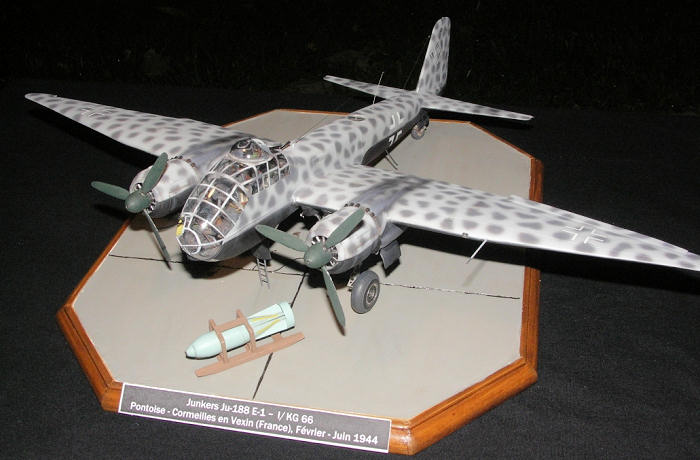
Dragon 1/48 Ju-188E-1
| KIT #: | 5518 |
| PRICE: | $ |
| DECALS: | Three options |
| REVIEWER: | Patrick Grué |
| NOTES: |
Eduard P-E kit # 49400 |

| HISTORY |
The Ju-188
Rächer (Avenger) was one of these well-known aircraft manufactured by the
Junkers Flugzeug und Motorenwerke AG (JFM) in
The Luftwaffe
needed a new advanced bomber to replace the aging He-111, Do-17 and Ju-88
bombers. The RLM conducted development of a new bomber, the Ju-288, but due to
delay in the development of the new Jumo 213 engine, this project could not be
ready on time. It was then decided to work on an interim solution: the Ju-188.
The Ju-188 was
developed in 1941 from the basic airframe and engines of the Ju-88B. JFM built
some Ju-88V experimental aircraft by extending the wingspan, enlarging the tail
planes and adding some new equipment. Finally the Ju-88 V44 was representative
of the Ju-188E series with its BMW 801 radial engines as well as its typical
egg-shaped cockpit. It flew for the first time on
In October 1942, the Ju-188 program was launched.
As the Jumo
213, a V-12 engine manufactured by JFM, was not yet ready for the Ju-188
production line, the RLM asked the Junkers factory to able the bomber being
motorized either with the BMW 801G
(1680 hp)
or the Jumo
213A
(1770 hp).
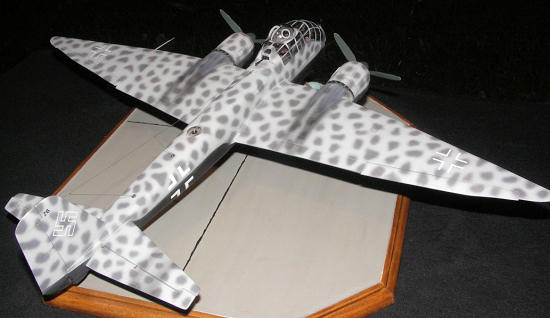 The
Ju-188A, B, C and D were level/ dive or torpedo bombers fitted with the Jumo 213
engines. The Ju-188E and F were respectively level/ dive bombers and long-range
reconnaissance aircraft fitted with the BMW 801 engines. However, for engine
development reason, the E version entered into production in February 1943,
almost one year before the A version. The Ju-188G was a level or torpedo bomber,
featuring a tail gunner and fitted with Jumo 213A engines. The Ju-188H, J, K, L,
R, S and T were projects for long-range and high-altitude reconnaissance
aircraft, night fighter and fast bomber. They could be motorized either with the
BMW 801J (1810 hp) or Jumo 213E (2000 hp) engines. They were prototypes of the
Ju-388 series forthcoming in 1944 which finally superseded the Ju-288 initial
project.
The
Ju-188A, B, C and D were level/ dive or torpedo bombers fitted with the Jumo 213
engines. The Ju-188E and F were respectively level/ dive bombers and long-range
reconnaissance aircraft fitted with the BMW 801 engines. However, for engine
development reason, the E version entered into production in February 1943,
almost one year before the A version. The Ju-188G was a level or torpedo bomber,
featuring a tail gunner and fitted with Jumo 213A engines. The Ju-188H, J, K, L,
R, S and T were projects for long-range and high-altitude reconnaissance
aircraft, night fighter and fast bomber. They could be motorized either with the
BMW 801J (1810 hp) or Jumo 213E (2000 hp) engines. They were prototypes of the
Ju-388 series forthcoming in 1944 which finally superseded the Ju-288 initial
project.
Most of
the Luftwaffe bombers were equipped with electronic devices for navigation aids
during the
The Ju-188
also featured the Lorenz instrument
landing
system used in poor weather or night conditions (Landefunkfeuer or LFF).
The
Ju-188 could carry 3,000 kg of bombs spread out in two internal bomb bays and
four attaching points under wings. The wing inner ports were mainly used for
heavy stores: 1,000/ 1,400/ 1,800 kg bombs or 2x900L drop tanks whereas outer
ports were used for 250/ 500 kg bombs. The fuselage ports were mainly dedicated
to 50 kg bomblets: 900 kg max in the forward bay and 500 kg max in the rear bay.
The internal bomb bays could be replaced by two additional fuel tanks of 700L
each.
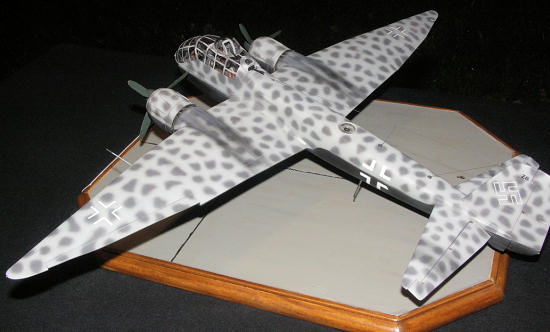 The
defense armament was made of:
The
defense armament was made of:
§
one MG
151 (20 mm caliber) forward-firing canon with 200 rounds
Performances and characteristics:
The
twin-engine bomber Ju-188 E-1 was operated by four airmen and could fly at a
maximum cruising speed of 500 km/h at 6,000 m without stores. The max ceiling
was 9,500 m.
Range is
always dependent of the balance between the bomb load and the carried fuel so as
the max take-off weight shall never be exceeded. With a cruising speed of 400
km/h, the Ju-188 could range:
§
1,300 km
with 3,000 kg of bombs and 1,680L of fuel
§
3,000 km
with 2,000 kg of bombs and 3,580L of fuel
§
3,800 km
with 1,000 kg of bombs and 4,480L of fuel
Featuring
a wingspan of 22 m, a length of 14.96 m and a height of 4.90 m, its empty weight
was 9,900 kg and the maximum take-off weight was 15,000 kg.
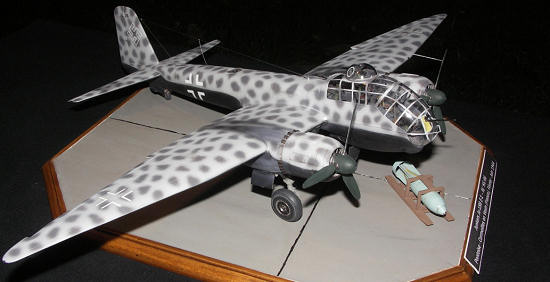 The
Ju-188s were widely used over the Atlantic, North Sea and Mediterranean theatre
in shipping attacks before being allocated to ground targets. On 18 August 1943
the Ju-188E-1s of I/ KG 66 took part in their first bombing operation over an
industrial target near Lincoln.
The
Ju-188s were widely used over the Atlantic, North Sea and Mediterranean theatre
in shipping attacks before being allocated to ground targets. On 18 August 1943
the Ju-188E-1s of I/ KG 66 took part in their first bombing operation over an
industrial target near Lincoln.
The
Ju-188s carried out their most important bombing sorties during Operation
Steinbock
(aka
Baby
Blitz) between
January and May 1944.
Operation
Steinbock
(Capricorn)
was a reprisal following the
night
bombings of German cities during summer 1943 by the RAF. This operation
was a night bombing offensive against military and civilian targets located in
southern England including London area.
Many
Luftwaffe bomber units took part in this operation which involved more than 500
bombers such as Ju-88, Do-217, He-177, Ju-188 and also some Me-410 and Fw-190
fighter-bombers. The bombers dropped 70% incendiary and 30% high explosive
bombs, including 1,000 kg bombs and land mines.
Many
Ju-188E-1s of I/ KG 66 and KG 2 were used as pathfinders and illuminators by
dropping parachute flares as sky markers and
incendiary bomblets as ground markers;
to this purpose their rotating turret was removed to increase speed as marker
aircraft.
However
Operation
Steinbock
had worn
out the Luftwaffe bomber fleet which recorded 63% of losses. That long operation
put an end to the large-scale offensives against England with bombers and
afterwards only V-1 flying bombs and V-2 rockets were used.
After
Allied invasion of France in June 1944, the Ju-188s and Ju-88s of I/ KG 66 were
used against military targets and later during
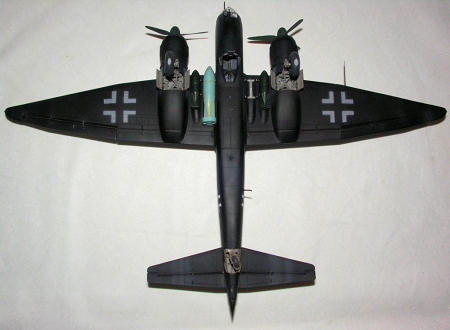 the Ardennes offensive in
December. Between March and April 1945, in an ultimate attempt to stop the Red
Army, the Ju-188s took part in operations against the Oder bridges as
pathfinders for Mistel elements of KG 30.
the Ardennes offensive in
December. Between March and April 1945, in an ultimate attempt to stop the Red
Army, the Ju-188s took part in operations against the Oder bridges as
pathfinders for Mistel elements of KG 30.
Note:
Mistel was a twin-aircraft combination consisting of an unmanned Ju-88 featuring
a 1,800 kg warhead instead of the cockpit, and a piloted fighter as guidance
aircraft (Fw-190 or Bf-109) fitted above the “kamikaze” bomber.
Despite
its good flying qualities, expected performances of the Ju-188 were not really
better than those of the last versions of the Ju-88 it was supposed to replace.
Finally the Ju-388 was the real outcome of this Junkers bomber series but it
was developed too late in the war to make much of a combat contribution.
Junkers built 1,237 Ju-188s. Some captured Ju-188E/F served in the French Navy after war as torpedo bombers until 1951 before being scraped. Unfortunately none of this sleek bomber has been preserved in a museum.
| THE KIT |
This kit features 182 parts including 27
photo-etched parts in steel, but only 138 parts are dedicated to the E-1
version. The other parts are for the A version or for the Ju-88. The transparent
parts are excellent even better than the grey parts. All the control surfaces
are separated except for the flaps.
The Eduard photo-etched set features 134 parts
in brass including pre-painted self-adhesive parts for the miscellaneous
instrument panels, consoles and seat belts.
The small decal sheet suggests three options: one marking for a KG 6 aircraft, one marking for a reconnaissance unit and one marking for a KG 66 aircraft based in France. I did not use them as the decals were yellowish and glossy.
| CONSTRUCTION |
Cockpit:
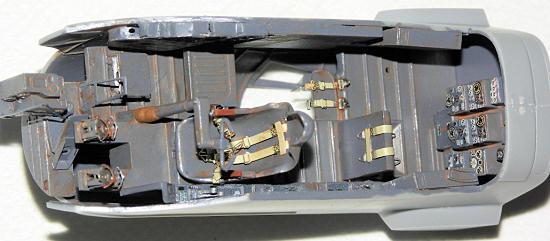 All details are concentrated in the nose. You
can independently build the cockpit in its frame as the whole fuselage is
separated in a front part (cockpit) and in a rear part (from wing leading edge
to tail). There are 120 Eduard photo-etched parts for the cockpit and only 30
original plastic parts including front fuselage halves, floor and transparent
parts. Gosh, that took me loads of time to fix the 150 parts of the cockpit!
All details are concentrated in the nose. You
can independently build the cockpit in its frame as the whole fuselage is
separated in a front part (cockpit) and in a rear part (from wing leading edge
to tail). There are 120 Eduard photo-etched parts for the cockpit and only 30
original plastic parts including front fuselage halves, floor and transparent
parts. Gosh, that took me loads of time to fix the 150 parts of the cockpit!
I used Humbrol #125 for RLM 66 cockpit color
which best matches with the pre-painted photo-etched parts, with a final wash in
burnt Sienna.
The whole canopy is not easy to fix and needs
some delicate adjustments as the machine guns are already glued on the cockpit
floor. I regret that the turret does not have any free rotating device in that
scale, so it was glued after adding some lacking details on it (seat, back seat
and ammo box).
Engines:
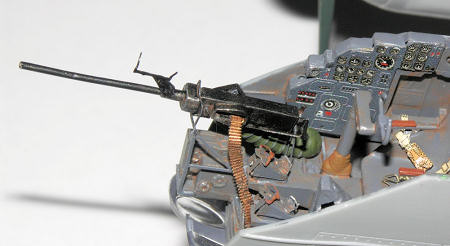 The two engines are very simplified and I
expected better for a kit released in 1994. Two aftermarket BMW 801 engines
should be appreciated here. But it is not very important as the engine is hidden
afterwards by the fan cooler. I applied a coat of “steel” paint and highlighted
some details in grey, black and copper.
The two engines are very simplified and I
expected better for a kit released in 1994. Two aftermarket BMW 801 engines
should be appreciated here. But it is not very important as the engine is hidden
afterwards by the fan cooler. I applied a coat of “steel” paint and highlighted
some details in grey, black and copper.
Fuselage and tail wheel:
The tail wheel is nicely detailed and there are
some p-e parts for the wheel well. However the leg seems flimsy when the
complete kit applies its weight on it.
As usual in Dragon's products, problems of poor
fit occur when the two fuselage halves are glued: the fuselage halves do not
match perfectly as well as the panel lines. Unfortunately, filling, sanding and
re-engraving operations are unavoidable here.
Wings and stabilizers:
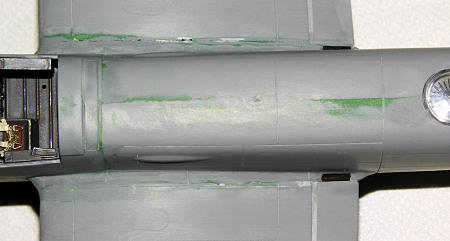 I started to fix the vertical and horizontal
stabilizers before the wings and then the elevators in folded position.
I started to fix the vertical and horizontal
stabilizers before the wings and then the elevators in folded position.
The wing tips are separated from the main parts
as well as the ailerons. But the problems of poor fit are back: the wing tip
thickness does not perfectly match with the wing as well as some panel lines.
One of the main flaw of this kit is the wing
root sealing with the fuselage: the wing profile does not match correctly
between the two parts and moreover the dihedral adjustment is approximate due
to a free adjustment instead of a tighter one. Here again I could not avoid the
drudgery of machining, filling and sanding.
The ailerons are in banked position in
accordance with the control wheel position (LH side).
Landing gear and wheel well:
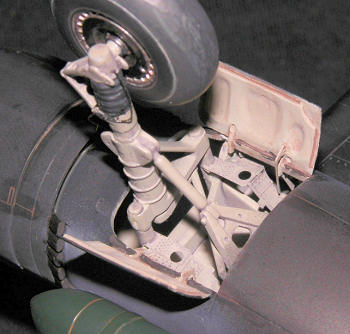 The landing gear has to be fixed into the wings
prior to the engine nacelles. No problem here with the legs that fit correctly
to the attaching points. Some p-e parts give an upgrade to the gear assembly.
However the wheels are a bit simple and could be improved.
The landing gear has to be fixed into the wings
prior to the engine nacelles. No problem here with the legs that fit correctly
to the attaching points. Some p-e parts give an upgrade to the gear assembly.
However the wheels are a bit simple and could be improved.
The wheel wells and gear legs are in RLM 02
grey-beige with a wash in burnt Sienna.
Nacelles and propellers:
The engine nacelles are glued at the last step
of the con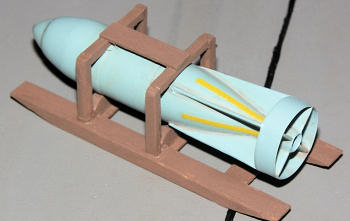 struction. They also needs some putty.
struction. They also needs some putty.
The propeller blades and spinners are in black
green and are installed after the aircraft be painted.
Bombs and supports:
No bomb is provided in the kit. So I took two SC500 bombs from a Bf-110 spare parts and scratch-built the big “Hermann” SC1000 bombs from documents I found in Internet. The SC500 are black green whereas the SC1000 are light blue (Humbrol #65). The wooden trolley of the SC1000 is scratch-built from matches.
| COLORS & MARKINGS |
The Dragon painting guide is subject to caution
since it does not refer to RLM colors, but suggests inappropriate references
from Italeri Model Master paints, as well as some Gunze reference paints which
have to be mixed together. In my opinion it is not necessary to follow this
guide as RLM colors are nowadays available and easy to find among paint
manufacturers.
Following my reference books, I chose a typical
camouflage scheme applied on the night bombers: the lower surfaces are in RLM 22
flat black and the upper surfaces are in RLM 76
light
grey-blue with dot or vermicelli mottling in
RLM 74 grey-green. 
Note that the last release of the 1/72 Hasegawa
Ju-188 suggests the mottling be in RLM 70 black green over RLM 76 for two
aircraft of the same unit. As you want folks, I wasn't yet born to say that it
wasn't like this...but I prefer RLM 74 over RLM 76!
The upper surfaces could also wear a typical
RLM70/71 green splinter pattern over RLM 22, with RLM 76 vermicelli mottling
applied over the green pattern. In fact there are many options to have a
non-standard Ju-188.
Once all the surfaces have been sanded for a
better aspect and paint covering, I put the masks all around the model,
particularly on the huge vitreous nose. My advice here: buy the pre-cut masks if
you can!
I started to airbrush the lower surfaces and
the main panel lines of the upper surfaces in RLM 22 using Gunze acrylic paints.
Then all the upper surfaces were airbrushed in RLM 76, and the mottling free
hand in RLM 74.
The intrados crosses are painted in RLM 77 grey
using masks whereas the white crosses and swastikas are decals from my spare
box. There is no ID number on the fuselage sides except a small Z6 code on top
of the fin (KG 66 identifier). The decals are protected by a mat varnish.
My aircraft is of the I/ KG 66 (first group of
bomber wing 66) when the third squadron (Staffel 3) was based near Paris
at Cormeilles airfield between February and June 1944. This unit used both
Ju-88s and Ju-188s and shared the airfield with the Fw-190 fighters of JG 2.
Note that nowadays this airfield is still active for civilian use and better
known as Pontoise Cormeilles en Vexin (LFPT). The two hard runways were
originally built by the Germans.
| CONCLUSIONS |
| REFERENCES |
§
Junkers Ju-188, by Helmut Erfurth (Midland
Publishing 2003)
§
Ju-188 & Ju-388, by Robert Michulec (AJ-Press
1997, original Polish version)
§
The Luftwaffe over the Bristol area, 1940-1944
by John Penny
December 2010
Copyright ModelingMadness.com. All rights reserved. no reproduction in part or in whole without express permission from the editor.
If you would like your product reviewed fairly and quickly, please contact the editor or see other details in the Note to Contributors.